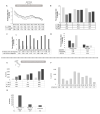Real-World Evidence on Disease Burden and Economic Impact of Sickle Cell Disease in Italy
- PMID: 36614918
- PMCID: PMC9821386
- DOI: 10.3390/jcm12010117
Real-World Evidence on Disease Burden and Economic Impact of Sickle Cell Disease in Italy
Abstract
A real-world analysis was conducted in Italy among sickle cell disease (SCD) patients to evaluate the epidemiology of SCD, describe patients' characteristics and the therapeutic and economic burden. A retrospective analysis of administrative databases of various Italian entities was carried out. All patients with ≥1 hospitalization with SCD diagnosis were included from 01/2010-12/2017 (up to 12/2018 for epidemiologic analysis). The index date corresponded to the first SCD diagnosis. In 2018, SCD incidence rate was 0.93/100,000, the prevalence was estimated at 13.1/100,000. Overall, 1816 patients were included. During the 1st year of follow-up, 50.7% of patients had one all-cause hospitalization, 27.8% had 2, 10.4% had 3, and 11.1% had ≥4. Over follow-up, 6.1-7.2% of patients were treated with SCD-specific, 58.4-69.4% with SCD-related, 60.7-71.3% with SCD-complications-related drugs. Mean annual number per patient of overall treatments was 14.9 ± 13.9, hospitalizations 1.1 ± 1.1, and out-patient services 5.3 ± 7.6. The total mean direct cost per patient was EUR 7918/year (EUR 2201 drugs, EUR 3320 hospitalizations, and EUR 2397 out-patient services). The results from this real-world analysis showed a high disease burden for SCD patients with multiple hospitalizations during the follow-up. High healthcare resource utilization and costs were associated with patient' management and were most likely underestimated since indirect costs and Emergency Room admissions were not included.
Keywords: SCD epidemiology; administrative databases; real-life; transfusions; vaso-occlusive crisis.
Conflict of interest statement
De Franceschi L. is a medical consultant for Novartis, Roche, and received a research grant from Agios. Forni G.L. is a medical consultant for Novartis, Celgene, BlueBirdBio. Castiglioni C., Condorelli C., Valsecchi D. and Premoli E. are employees of Novartis Farma S.p.A., Italy. Perrone V. and Degli Esposti L. are employees of CliCon S.r.l. Società Benefit. Fiocchi C. was an employee of Novartis Farma S.p.A., Italy, and of Blueprint Medicines Italy from 30 September 2021.
Figures




Similar articles
-
Economic and Clinical Burden of Managing Sickle Cell Disease with Recurrent Vaso-Occlusive Crises in the United States.Adv Ther. 2023 Aug;40(8):3543-3558. doi: 10.1007/s12325-023-02545-7. Epub 2023 Jun 18. Adv Ther. 2023. PMID: 37332020 Free PMC article.
-
The Direct Medical Costs of Sickle Cell Disease in Saudi Arabia: Insights from a Single Center Study.Healthcare (Basel). 2025 Feb 15;13(4):420. doi: 10.3390/healthcare13040420. Healthcare (Basel). 2025. PMID: 39997295 Free PMC article.
-
Epidemiology and disease burden of sickle cell disease in France: A descriptive study based on a French nationwide claim database.PLoS One. 2021 Jul 9;16(7):e0253986. doi: 10.1371/journal.pone.0253986. eCollection 2021. PLoS One. 2021. PMID: 34242255 Free PMC article.
-
Real-World Evidence of the Clinical and Economic Impact of Long-Acting Injectable Versus Oral Antipsychotics Among Patients with Schizophrenia in the United States: A Systematic Review and Meta-Analysis.CNS Drugs. 2021 May;35(5):469-481. doi: 10.1007/s40263-021-00815-y. Epub 2021 Apr 28. CNS Drugs. 2021. PMID: 33909272 Free PMC article.
-
Current challenges in the management of patients with sickle cell disease - A report of the Italian experience.Orphanet J Rare Dis. 2019 May 30;14(1):120. doi: 10.1186/s13023-019-1099-0. Orphanet J Rare Dis. 2019. PMID: 31146777 Free PMC article. Review.
Cited by
-
Quality of Life and Out-of-Pocket Expenditures for Sickle Cell Disease Patients in Saudi Arabia: A Single-Center Study.Healthcare (Basel). 2024 Oct 29;12(21):2146. doi: 10.3390/healthcare12212146. Healthcare (Basel). 2024. PMID: 39517358 Free PMC article.
-
Ten years of a neonatal screening program for hemoglobinopathies in Friuli-Venezia Giulia: first regional experience in Italy.Blood Transfus. 2024 Nov;22(6):529-536. doi: 10.2450/BloodTransfus.646. Epub 2023 Nov 30. Blood Transfus. 2024. PMID: 38063788 Free PMC article.
-
The phenotypes of sickle cell disease: strategies to aid the identification of undiagnosed patients in the Italian landscape.Ital J Pediatr. 2025 May 28;51(1):157. doi: 10.1186/s13052-025-01992-y. Ital J Pediatr. 2025. PMID: 40437545 Free PMC article. Review.
-
Mortality, Clinical Complications, and Healthcare Resource Utilization Associated with Managing Transfusion-Dependent β-Thalassemia and Sickle Cell Disease with Recurrent Vaso-occlusive Crises in Italy.Pharmacoecon Open. 2025 Jan;9(1):115-124. doi: 10.1007/s41669-024-00532-4. Epub 2024 Oct 28. Pharmacoecon Open. 2025. PMID: 39468000 Free PMC article.
-
Hydroxyurea Pharmacokinetic Evaluation in Patients with Sickle Cell Disease.Pharmaceuticals (Basel). 2024 Oct 17;17(10):1386. doi: 10.3390/ph17101386. Pharmaceuticals (Basel). 2024. PMID: 39459025 Free PMC article.
References
-
- Cordovil K. Sickle Cell Disease: A Genetic Disorder of Beta-Globin. In: AL-Zwaini I., editor. Thalassemia and Other Hemolytic Anemias. InTech; London, UK: 2018.
-
- De Franceschi L., Brugnara C., Rouyer-Fessard P., Jouault H., Beuzard Y. Formation of Dense Erythrocytes in SAD Mice Exposed to Chronic Hypoxia: Evaluation of Different Therapeutic Regimens and of a Combination of Oral Clotrimazole and Magnesium Therapies. Blood. 1999;94:4307–4313. doi: 10.1182/blood.V94.12.4307. - DOI - PubMed
-
- Kalish B.T., Matte A., Andolfo I., Iolascon A., Weinberg O., Ghigo A., Cimino J., Siciliano A., Hirsch E., Federti E., et al. Dietary ω-3 Fatty Acids Protect against Vasculopathy in a Transgenic Mouse Model of Sickle Cell Disease. Haematologica. 2015;100:870–880. doi: 10.3324/haematol.2015.124586. - DOI - PMC - PubMed
Grants and funding
LinkOut - more resources
Full Text Sources
Medical

